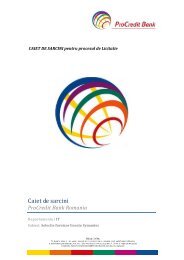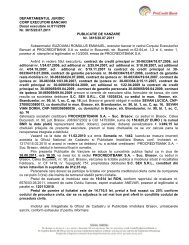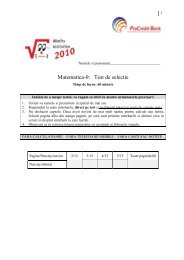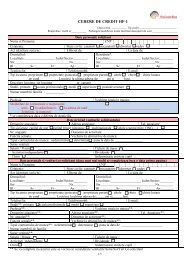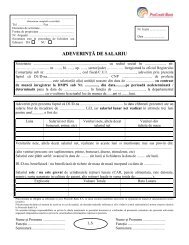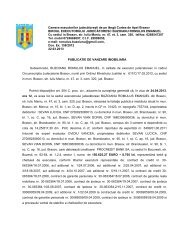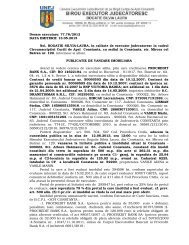Annual Report 2010 - ProCredit Bank
Annual Report 2010 - ProCredit Bank
Annual Report 2010 - ProCredit Bank
You also want an ePaper? Increase the reach of your titles
YUMPU automatically turns print PDFs into web optimized ePapers that Google loves.
assets and liabilities denominated in foreign currencies that are<br />
measured at fair value are retranslated to the functional currency<br />
at the exchange rate at the date that the fair value was determined.<br />
Foreign currency differences arising on retranslation are recognised<br />
in profit or loss, except for differences arising on the retranslation<br />
of available-for-sale equity instruments.<br />
The exchange rates of major foreign currencies were:<br />
Currency 31 December 31 December Increase<br />
<strong>2010</strong> 2009 %<br />
Euro (EUR) 1: RON 4.2848 1: RON 4.2282 1.34 %<br />
US Dollar (USD) 1: RON 3.2045 1: RON 2.9361 9.14%<br />
ii. Translation from functional to presentation currency<br />
All assets and liabilities for all balance sheets presented (including<br />
comparatives) have been translated from the functional currency<br />
to the presentation currency at the closing rate existing at the date<br />
of each balance sheet presented. Income and expense for all periods<br />
presented (including comparatives) have been translated using<br />
an average rate for the period (unless this average is not a reasonable<br />
approximation of the cumulative effect of the rates prevailing<br />
on the transaction dates, in which case income and expenses are<br />
translated at the dates of the transactions). Share capital, retaining<br />
earnings and all other reserves are translated at closing rates.<br />
All exchange differences resulting from translation have been recognised<br />
directly as a separate component in equity as translation<br />
reserve.<br />
The restatement and presentation procedures used according with<br />
IAS 21 - The Effects of Changes in Foreign Exchange Rates, could<br />
result in distortion of the figures presented in EUR compared with<br />
real values.<br />
b) Interest<br />
Interest income and expense are recognised in the income statement<br />
using the effective interest method. The effective interest rate<br />
is the rate that exactly discounts the estimated future cash payments<br />
and receipts through the expected life of the financial asset<br />
or liability (or, where appropriate, a shorter period) to the carrying<br />
amount of the financial asset or liability. The effective interest rate<br />
is established on initial recognition of the financial asset and liability<br />
and is not revised subsequently.<br />
The calculation of the effective interest rate includes all fees and<br />
points paid or received transaction costs, and discounts or premiums<br />
that are an integral part of the effective interest rate. Transaction<br />
costs are incremental costs that are directly attributable to the<br />
acquisition, issue or disposal of a financial asset or liability.<br />
Interest income and expense presented in the income statement<br />
include interest on financial assets and liabilities at amortised cost<br />
on an effective interest rate basis and interest on available-for-sale<br />
investment securities calculated on effective interest basis.<br />
c) Fees and commission<br />
Fees and commission income and expenses that are integral to the<br />
effective interest rate on a financial asset or liability are included in<br />
the measurement of the effective interest rate.<br />
Other fees and commission income, including account servicing<br />
fees, foreign currency transactions fees, fees for guarantees given<br />
and opening of letter of credit fees are recognised as the related<br />
services are performed on an accrual basis.<br />
Other fees and commission expense relates mainly to transaction<br />
and service fees, which are expensed as the services are received.<br />
d) Net trading income<br />
Net trading income comprises gains less loss related to foreign exchange<br />
operations.<br />
e) Dividends<br />
Dividend income is recognised when the right to receive income<br />
is established. Usually this is the ex-dividend date for equity securities.<br />
Dividends are reflected as a component of other operating<br />
income based on the underlying classification of the equity<br />
instrument.<br />
Dividends are treated as an appropriation of profit in the period<br />
they are declared and approved by the General Assembly of Shareholders.<br />
The only profit available for distribution is the profit for<br />
the year recorded in the Romanian statutory accounts, which differs<br />
from the profit in these financial statements, prepared in accordance<br />
with IFRS, due to the differences between the applicable<br />
Romanian Accounting Regulations and IFRS.<br />
f) Lease payments made<br />
Payments made under operating leases are recognised in profit or<br />
loss on a straight-line basis over the term of the lease. Lease incentives<br />
received are recognised as an integral part of the total lease<br />
expense, over the term of the lease.<br />
g) Income tax<br />
Financial Statements 53<br />
Income tax comprises current and deferred tax. Income tax is recognised<br />
in the income statement except to the extent that it relates<br />
to items recognised directly in equity, in which case it is recognised<br />
in equity.<br />
Current tax is the expected tax payable on the taxable income for<br />
the year, using tax rates enacted or substantively enacted at the<br />
balance sheet date, and any adjustment to tax payable in respect<br />
of previous years. For the year ended 31 December <strong>2010</strong> the current<br />
profit tax rate was 16% (31 December 2009: 16%).<br />
Deferred tax is provided using the balance sheet method, providing<br />
for temporary differences between the carrying amounts of assets<br />
and liabilities for financial reporting purposes and the amounts<br />
used for taxation purposes. Deferred tax is not recognised for the<br />
following temporary differences: the initial recognition of goodwill,<br />
the initial recognition of assets or liabilities in a transaction that<br />
is not a business combination and that affects neither accounting<br />
nor taxable profit, and differences relating to investments in<br />
subsidiaries to the extent that they probably will not reverse in the<br />
foreseeable future. Deferred tax is measured at the tax rates that<br />
are expected to be applied to the temporary differences when they<br />
reverse, based on the laws that have been enacted or substantively<br />
enacted by the reporting date. The tax rate used to calculate the<br />
deferred tax position for the <strong>Bank</strong> at 31 December <strong>2010</strong> is 16% (31<br />
December 2009: 16%).<br />
A deferred tax asset is recognised only to the extent that it is probable<br />
that future taxable profits will be available against which the<br />
asset can be utilised. Deferred tax assets are reviewed at each reporting<br />
date and are reduced to the extent that it is no longer probable<br />
that the related tax benefit will be realised.<br />
Additional income taxes that arise from the distribution of dividends<br />
are recognised at the same time as the liability to pay the<br />
related dividend is recognised.




